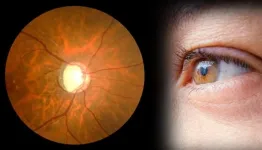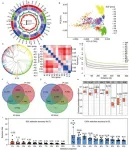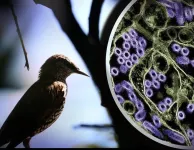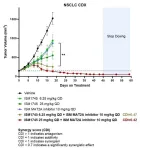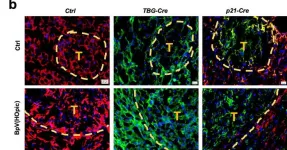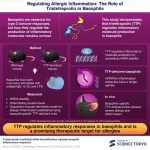(Press-News.org)
Glaucoma is a progressive eye disorder characterized by fluid buildup inside the eye, causing ocular hypertension. By 2040, it is estimated that 111.8 million people worldwide will be affected by glaucoma, potentially leading to blindness if left untreated. Currently, there are treatments available to manage ocular hypertension, but a cure for glaucoma remains elusive.
Retinal ganglion cells (RGCs) are crucial for transmitting visual signals from the eyes to the brain, and their degeneration leads to optic nerve damage, which is a hallmark of glaucoma. In recent years, scientists have focused on developing neuroprotective drugs that can rescue RGCs and restore the optic nerve pathways. Necroptosis, a pathway responsible for programmed cell death, plays a significant role in the loss of RGCs. Unlike other forms of cell death, necroptosis shares features of both apoptosis (natural cell breakdown) and necrosis (injury-related cell damage). Receptor-interacting protein kinase 3 (RIPK3), a key signaling molecule, is known to play a critical role in necroptosis, making it a promising target for therapeutic intervention.
To identify potential RIPK3 inhibitors, a team of researchers from different research facilities and medical centers in China came together to conduct an artificial intelligence (AI)-driven drug screening technique and identify the potential target compounds of RIPK3. The study, led by Dr. Yuanxu Gao from Macau University of Science and Technology and Professor Zhang Kang from Guangzhou National Laboratory, was published in the Chinese Medical Journal and made available online in December 23rd, 2024. “AI provides reliable tools and methods for drug discovery, such as virtual screening, quantitative structure-activity relationship modeling, and de novo drug design,” says Dr. Gao, speaking about the motivation behind the study.
The team utilized advanced AI models, including a large language model and graph neural network models, to identify RIPK3-targeting molecules. Even though the command, “small-molecule compounds targeting RIPK3,” was the same throughout numerous engagements with ChatGPT 3.5, the team got a randomized AI-generated list. The team also used multiple AI models, including DynamicBind, to predict the drug-RIPK3 affinity and interaction pattern. Complex-conformation prediction using molecular dynamics simulation along with in silico analysis of absorption, distribution, metabolism, excretion, and toxicity (ADMET) of the molecules were also performed. To validate these findings, the team conducted biological experiments, including cell viability assays, immunofluorescence, histological analysis, and protein quantification.
Using AI, the team identified HG9-91-01, dabrafenib, AZD5423, GSK840, and HS-1371 as the most potent small-molecule compounds that can effectively target RIPK3. According to affinity-score prediction models, HG9-91-01 was considered to be the most promising candidate for targeting RIPK3. The suitability of HG9-91-01 was confirmed by molecular simulations, demonstrating that it formed a more stable complex with RIPK3 compared to other options. The compound also exhibited good results in safety and drug-related tests as per the ADMET predictions.
The compound’s efficacy was validated through laboratory experiments. In an in vitro model mimicking optic nerve damage, RGCs exposed to oxygen-glucose deprivation (OGD) showed higher survival rates when treated with HG9-91-01 compared to other candidates. The compound also reduced the presence of gasdermin D (GSDMD)-positive cells, a marker of pyroptosis, a type of inflammatory cell death. Highlighting an interesting aspect of this study, Prof. Kang says, “Although numerous studies have focused on anti-apoptotic, anti-necroptotic, and anti-pyroptotic drugs for treating acute ocular hypertension (AOH), strategies targeting PANoptosis, including cell-cell communication and cascade reactions of cell death, are rarely mentioned. In this study, we investigated potential drug treatments targeting RIPK3 to prevent RGC death and explored their role in preventing PANoptosis.”
In vivo experiments involving mouse models also showed positive results. Retinal thinning is often associated with glaucoma and increased ocular pressure. However, treatment with HG9-91-01 molecule prevented the loss of retinal thickness. It also reduced the activation of signaling molecules associated with apoptosis, pyroptosis, and necroptosis, suggesting its potential in preventing PANoptosis.
The findings of this study provide interesting insights into the combination of AI algorithms and traditional drug screening methods, that might lead to a logical and data-driven drug development model. Biological research investigating drug-target interaction necessitates a substantial amount of time and resources. AI-based prediction models simplify and expedite this process. “AI technologies are useful for handling computationally intensive tasks and making rational decisions based on complex multimodal knowledge. However, possible concerns such as data privacy, transparency, and bias should be addressed with caution,” concludes Dr. Gao.
In order to confirm that HG9-91-01 can protect the retinal structure in patients with AOH, the team plans on conducting further confirmatory retinal assessments. With AI-driven breakthroughs on the horizon, the future of glaucoma treatment looks brighter than ever!
Reference
DOI: https://doi.org/10.1097/CM9.0000000000003387
END
Maize is a globally cultivated staple crop and one of the most successful examples of heterosis utilization in food production. The development of elite inbred lines is critical for breeding hybrid varieties and achieving sustained yield improvements. However, efficient breeding of inbred lines faces significant challenges, including the broad origins of germplasm resources, complex and diverse genetic structures, and low accuracy in phenotypic prediction. Advances in modern genomics and artificial intelligence technologies ...
Pancreatic cancer kills 50,000 people each year, according to the National Cancer Institute, and there are few effective treatment options for the disease. In a new study, researchers at University of California San Diego School of Medicine have discovered that an enzyme called MICAL2 promotes tumor growth and spread in pancreatic ductal adenocarcinomas (PDAC), the most common form of pancreatic cancer. The study will be published on January 2, 2025 in Cancer Research, a journal of the American Association for Cancer Research.
Normally, MICAL2 plays an important role in cell migration and morphology. But when the researchers measured ...
WHAT:
Highly pathogenic H5N1 avian influenza A virus (HPAI H5N1) remains a low risk to the general public, and public health experts in the United States believe that available treatments and vaccines, as well as those in development, are sufficient to prevent severe disease. However, the National Institutes of Health (NIH) and its federal partners remain focused on monitoring the virus and evaluating changes, according to leading officials at the National Institute of Allergy and Infectious Diseases (NIAID), part of the NIH.
In a commentary published in the New England Journal of Medicine, NIAID Director Jeanne M. Marrazzo, M.D., M.P.H., and Michael G. Ison, M.D., M.S., chief ...
University of Iowa researchers are recommending all patients be surveyed about their physical activity levels, after a new study underscores the link between physical activity and chronic disease.
The study, led by Lucas Carr, associate professor in the Department of Health and Human Physiology, examined responses from more than 7,000 patients at University of Iowa Health Care Medical Center who noted their level of physical activity in a questionnaire.
From patients’ answers to the questionnaire, the researchers found that those who reported the highest level of physical activity — meaning they exercised moderately ...
Since 2021, Insilico Medicine has successfully nominated 22 preclinical candidates (PCCs) with the help of its proprietary Pharma.AI platform, among which 5 were nominated just the year of 2024.
The novel scaffold of ISM1745 is based on de novo generation results of Insilico’s Chemistry42, the generative AI platform combining more than 40 generative models.
With in vivo anti-tumor activity validated in multiple cancer models, the candidate compound showed robust in vivo efficacy as monotherapy as well as combination potential with chemotherapies, targeted agents including MAT2A inhibitor, and immunotherapies.
CAMBRIDGE, ...
Scientists at University of California San Diego School of Medicine have shed new light on the development of liver cancer, the sixth most frequently diagnosed cancer and fourth leading cause of cancer deaths worldwide. The study, published in Nature, reveals a complex interplay between cellular metabolism and DNA damage that drives the progression of fatty liver disease to cancer. The findings suggest new paths forward for preventing and treating liver cancer and have significant implications on our understanding of cancer’s origin and the effects of diet on our DNA.
The incidence of the most common form of liver cancer, hepatocellular carcinoma (HCC), has grown by 25-30% in the past ...
Inflammation is a crucial part of the body’s defense mechanism, playing a key role in fighting infections and repairing tissue damage. Basophils, a type of immune cell that makes up less than 1% of white blood cells, have recently emerged as critical players in triggering allergic responses by releasing pro-inflammatory cytokines like IL-4. Despite the established role of basophils in inflammation, the molecular mechanisms controlling their cytokine production have remained unclear.
To address this gap, a group of researchers from Institute of Science Tokyo, led by Professor Kensuke Miyake, conducted a study to explore the role of tristetraprolin ...
Researchers are aiming to bring the magic of playing music in person to the virtual world.
The Joint Active Music Sessions (JAMS) platform, created at the University of Birmingham, uses avatars created by individual musicians and shared with fellow musicians to create virtual concerts, practice sessions, or enhance music teaching.
Dr Massimiliano (Max) Di Luca from the University of Birmingham explains: “A musician records themselves and sends the video to another musician. The software creates a responsive avatar ...
One or two doses of psilocybin, a compound found in psychedelic mushrooms, may improve the mental health of cancer patients when accompanied by psychotherapy, a new report suggests. A second new study found that treatment with psilocybin resulted in lasting, positive personality changes in patients with alcohol use disorder.
The first report’s findings were published online Oct. 7 in the journal Nature Mental Health, and the second published online Jan. 1 in a special edition of The American Journal of Psychiatry focused on psilocybin research.
In the first study, a team of experts at NYU Langone Health found that psilocybin accompanied by psychotherapy significantly reduced anxiety, ...
To many, Vice President Kamala Harris’s loss in the 2024 presidential election was a sobering reminder of a larger and continuous gender gap across leadership positions in not only government, but also in business, higher education, and the military. A majority of Americans recognize the inadequacy of female representation in leadership, and the news media often portray women’s underrepresentation in these roles—but it nonetheless persists.
Recognizing that news coverage may have influence in forming attitudes and in driving ...
